Owners of medium and large cottages should plan their maintenance costs. Therefore, the task often arises to calculate the gas consumption for heating a house 200 m2 or larger area. The original architecture usually does not allow using the analogy method and finding ready-made calculations.
However, there is no need to pay money for this task. All calculations can be done by yourself. This will require knowledge of some regulations, as well as an understanding of physics and geometry at the school level.
We will help you understand this vital issue for the home economist. We will show you what formulas are used to calculate, what characteristics you need to know to get the result. The article presented by us provides examples on the basis of which it will be easier to make your own calculation.
The content of the article:
-
Finding the amount of energy loss
- Thermal conductivity and thermal resistance of the material
- Calculation of heat loss through enclosing structures
- Typical wall and roof geometry
- Heat loss through the floor and foundation
- Accounting for unheated premises
- Cooling through ventilation
- Gas consumption calculation
- Example for a 200 m2 cottage
- Conclusions and useful video on the topic
Finding the amount of energy loss
In order to determine the amount of energy that a house is losing, it is necessary to know the climatic features of the area, the thermal conductivity of materials and ventilation rates. And in order to calculate the required volume of gas, it is enough to know its calorific value. The most important thing in this work is attention to detail.
Heating the building must compensate for heat losses that occur for two main reasons: heat leakage around the perimeter of the house and the influx of cold air through the ventilation system. Both of these processes are described by mathematical formulas, according to which you can independently carry out calculations.
Thermal conductivity and thermal resistance of the material
Any material can conduct heat. The intensity of its transmission is expressed through the coefficient of thermal conductivity λ (W / (m × ° C)). The lower it is, the better the structure is protected from freezing in winter.
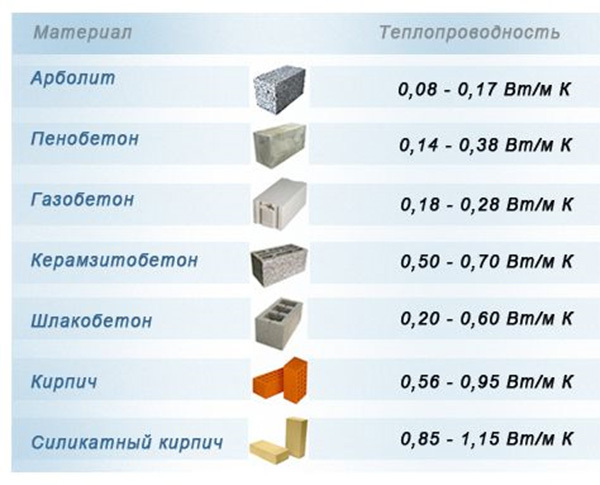
Heating costs depend on the thermal conductivity of the material from which the house will be built. This is especially important for the "cold" regions of the country.
However, buildings can be folded or insulated with materials of varying thicknesses. Therefore, in practical calculations, the coefficient of resistance to heat transfer is used:
R (m2 × ° C / W)
It is related to thermal conductivity by the following formula:
R = h / λ,
where h - material thickness (m).
Example. Let us determine the coefficient of resistance to heat transfer of D700 aerated concrete blocks of different widths at λ = 0.16:
- width 300 mm: R = 0.3 / 0.16 = 1.88;
- width 400 mm: R = 0.4 / 0.16 = 2.50.
For insulation materials and window blocks can be given both the coefficient of thermal conductivity and the coefficient of resistance to heat transfer.
If the enclosing structure consists of several materials, then when determining the coefficient of resistance to heat transfer of the entire “pie”, the coefficients of its individual layers are summed up.
Example. The wall is built of aerated concrete blocks (λb = 0.16), 300 mm thick. Outside, it is insulated extruded polystyrene foam (λp = 0.03) 50 mm thick, and from the inside sheathed with clapboard (λv = 0.18), 20 mm thick.
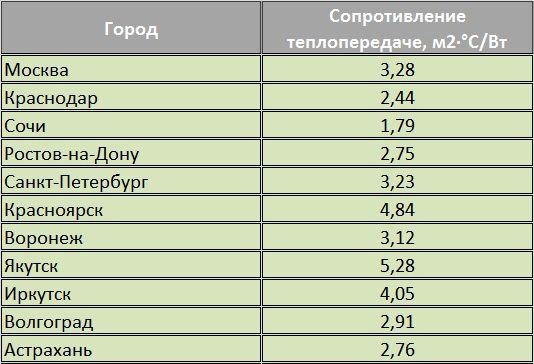
There are tables for different regions, in which the minimum values of the total heat transfer coefficient for the perimeter of the house are prescribed. They are advisory in nature.
Now you can calculate the total coefficient of resistance to heat transfer:
R = 0.3 / 0.16 + 0.05 / 0.03 + 0.02 / 0.18 = 1.88 + 1.66 + 0.11 = 3.65.
The contribution of layers that are insignificant in terms of the “heat saving” parameter can be neglected.
Calculation of heat loss through enclosing structures
Heat loss Q (W) across a uniform surface can be calculated as follows:
Q = S × dT / R,
where:
- S - the area of the considered surface (m2);
- dT - temperature difference between indoor and outdoor air (° С);
- R - coefficient of resistance to heat transfer of the surface (m2 * ° С / W).
To determine the total indicator of all heat loss, perform the following actions:
- allocate areas that are homogeneous in terms of the coefficient of resistance to heat transfer;
- calculate their areas;
- determine the indicators of thermal resistance;
- carry out the calculation of heat loss for each of the sections;
- summarize the obtained values.
Example. Corner room 3x4 meters on the top floor with a cold attic space. The final ceiling height is 2.7 meters. There are 2 windows measuring 1 × 1.5 m.
Let's find the heat loss through the perimeter at an air temperature inside “+25 ° С”, and outside - “–15 ° С”:
- Let's select areas that are homogeneous in terms of resistance coefficient: ceiling, wall, windows.
- Ceiling area SNS = 3 × 4 = 12 m2. Window area SO = 2 × (1 × 1.5) = 3 m2. Wall area Swith = (3 + 4) × 2.7 – SO = 29.4 m2.
- The coefficient of thermal resistance of the ceiling is made up of the overlap index (board with a thickness of 0.025 m), insulation (mineral wool slabs with a thickness of 0.10 m) and a wooden floor of the attic (wood and plywood with a total thickness of 0.05 m): RNS = 0.025 / 0.18 + 0.1 / 0.037 + 0.05 / 0.18 = 3.12. For windows, the value is taken from the passport of a double-glazed window: RO = 0.50. For a wall folded as in the previous example: Rwith = 3.65.
- QNS = 12 × 40 / 3.12 = 154 W. QO = 3 × 40 / 0.50 = 240 W. Qwith = 29.4 × 40 / 3.65 = 322 W.
- General heat loss of the model room through the enclosing structures Q = QNS + QO + Qwith = 716 W.
Calculation according to the formulas given gives a good approximation, provided that the material meets the declared heat-conducting qualities and there are no errors that can be made during construction. Aging of materials and construction of the house in general can also be a problem.
Typical wall and roof geometry
The linear parameters (length and height) of the structure when determining heat loss are usually taken to be internal, not external. That is, when calculating heat transfer through the material, the contact area of warm, not cold air is taken into account.
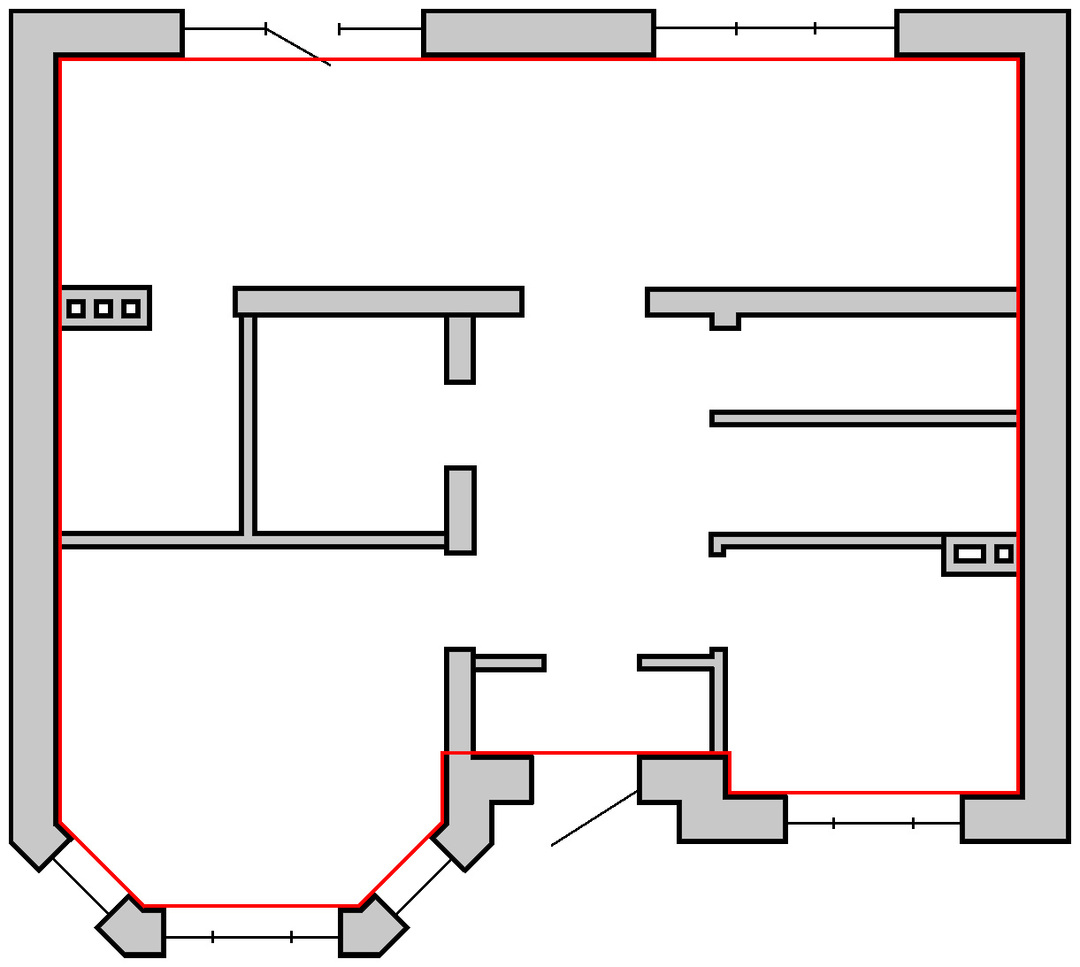
When calculating the inner perimeter, it is necessary to take into account the thickness of the interior partitions. The easiest way to do this is according to the plan of the house, which is usually printed on paper with a scale grid.
Thus, for example, with a house size of 8 × 10 meters and a wall thickness of 0.3 meters, the inner perimeter Pint = (9.4 + 7.4) × 2 = 33.6 m, and the outer Pout = (8 + 10) × 2 = 36 m.
Interfloor floors usually have a thickness of 0.20 to 0.30 m.Therefore, the height of two floors from the floor of the first to the ceiling of the second from the outside will be equal to Hout = 2.7 + 0.2 + 2.7 = 5.6 m.If you add only the finishing height, you get a smaller value: Hint = 2.7 + 2.7 = 5.4 m. The interfloor overlap, unlike the walls, does not have the function of insulation, therefore, for calculations, you need to take Hout.
For two-storey houses with dimensions of about 200 m2 the difference between the area of the walls inside and outside is from 6 to 9%. Similarly, the internal dimensions take into account the geometric parameters of the roof and floors.
Calculation of the area of the walls for simple geometry cottages is elementary, since the fragments consist of rectangular sections and pediments of attic and attic rooms.
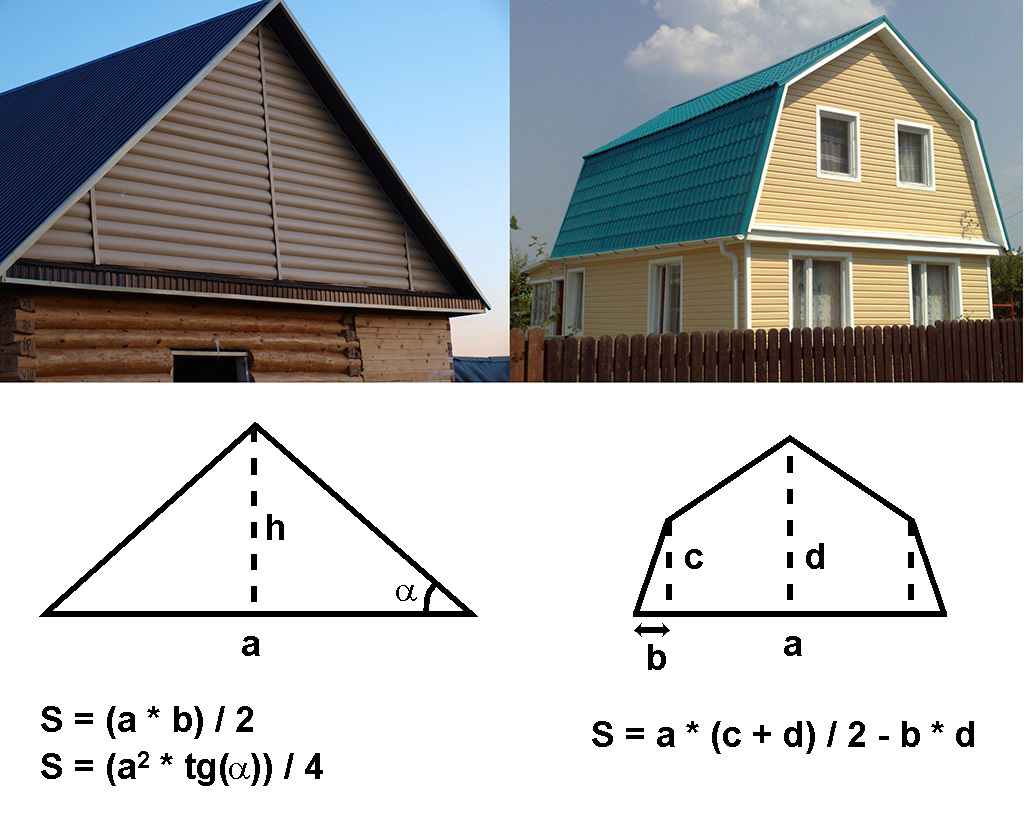
The gables of attics and attics in most cases have the shape of a triangle or a pentagon symmetrical along the vertical. Calculating their area is quite simple.
When calculating heat loss through the roof, in most cases it is sufficient to apply formulas to find the areas of a triangle, rectangle and trapezoid.

The most popular forms of roofs for private houses. When measuring their parameters, you need to remember that the internal dimensions are substituted into the calculations (without eaves)
The area of the laid roof cannot be taken when determining the heat loss, since it also goes to the overhangs, which are not taken into account in the formula. In addition, often the material (for example, roofing paper or profiled galvanized sheet) is placed with a slight overlap.
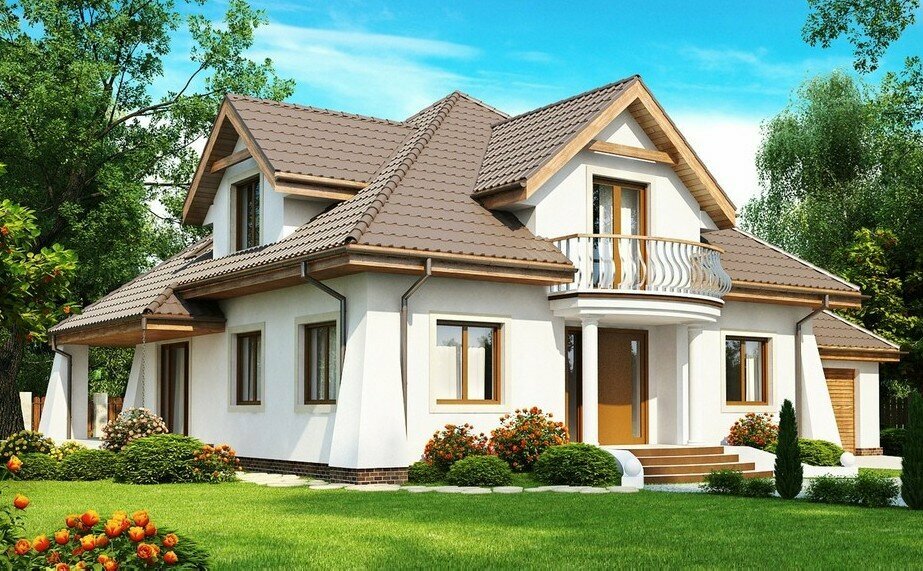
Sometimes it seems that calculating the roof area is quite difficult. However, inside the house, the geometry of the insulated fence of the upper floor can be much simpler.
The rectangular geometry of the windows also does not cause problems in calculations. If the double-glazed windows have a complex shape, then their area can not be calculated, but learned from the product passport.
Heat loss through the floor and foundation
Calculation of heat loss into the ground through the floor of the lower floor, as well as through the walls and the basement floor, is considered according to the rules prescribed in Appendix E of SP 50.13330.2012. The fact is that the rate of heat propagation in the earth is much lower than in the atmosphere, so soils can also be conditionally attributed to an insulation material.
But since they are characterized by freezing, the floor area is divided into 4 zones. The width of the first three is 2 meters, and the remainder is referred to the fourth.
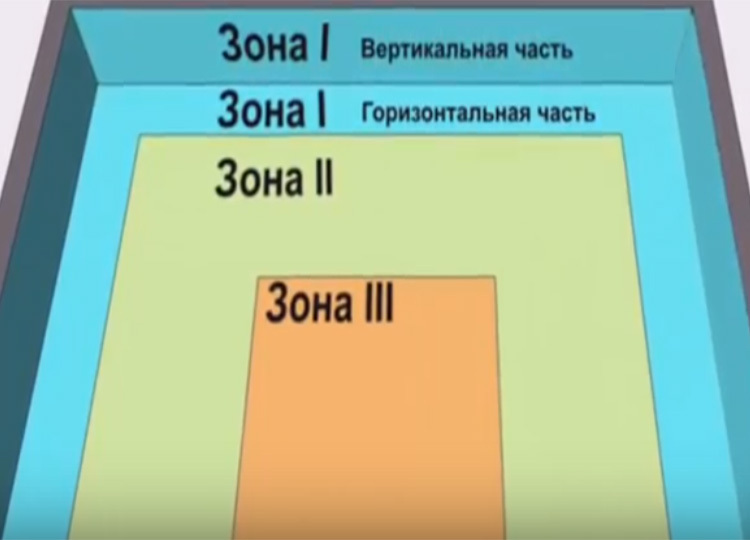
The heat loss zones of the floor and basement floor repeat the shape of the foundation perimeter. The main heat losses will go through zone No. 1
For each zone, the coefficient of resistance to heat transfer is determined, which is added by the soil:
- zone 1: R1 = 2.1;
- zone 2: R2 = 4.3;
- zone 3: R3 = 8.6;
- zone 4: R4 = 14.2.
If the floors are insulated, then to determine the total coefficient of thermal resistance, add up the indicators of the insulation and the soil.
Example. Let a house with external dimensions of 10 × 8 m and a wall thickness of 0.3 meters have a basement, 2.7 meters deep. Its ceiling is at ground level. It is necessary to calculate the heat loss to the soil at the internal air temperature “+25 ° С”, and the external one - “–15 ° С”.
Let the walls are made of FBS blocks, 40 cm thick (λf = 1.69). From the inside, they are sheathed with a board, 4 cm thick (λd = 0.18). The basement floor is filled with expanded clay concrete, 12 cm thick (λTo = 0.70). Then the coefficient of thermal resistance of the basement walls: Rwith = 0.4 / 1.69 + 0.04 / 0.18 = 0.46, and gender RNS = 0.12 / 0.70 = 0.17.
The internal dimensions of the house will be 9.4 × 7.4 meters.

The scheme of dividing the basement into zones for the problem being solved. Calculating areas with such a simple geometry comes down to determining the sides of rectangles and multiplying them
Let's calculate the areas and heat transfer resistance coefficients by zones:
- Zone 1 only runs along the wall. It has a perimeter of 33.6 m and a height of 2 m. Therefore S1 = 33.6 × 2 = 67.2. Rh1 = Rwith + R1 = 0.46 + 2.1 = 2.56.
- Zone 2 on the wall. It has a perimeter of 33.6 m and a height of 0.7 m. Therefore S2c = 33.6 × 0.7 = 23.52. Rs2s = Rwith + R2 = 0.46 + 4.3 = 4.76.
- Zone 2 by floor. S2p = 9.4 × 7.4 – 6.8 × 4.8 = 36.92. Rz2p = RNS + R2 = 0.17 + 4.3 = 4.47.
- Zone 3 only runs along the floor. S3 = 6.8 × 4.8 – 2.8 × 0.8 = 30.4. Rh3 = RNS + R3 = 0.17 + 8.6 = 8.77.
- Zone 4 only runs along the floor. S4 = 2.8 × 0.8 = 2.24. Rh4 = RNS + R4 = 0.17 + 14.2 = 14.37.
Heat loss of the basement floor Q = (S1 / Rh1 + S2c / Rs2s + S2p / Rz2p + S3 / Rh3 + S4 / Rh4) × dT = (26.25 + 4.94 + 8.26 + 3.47 + 0.16) × 40 = 1723 W.
Accounting for unheated premises
Often, when calculating heat loss, a situation arises when there is an unheated, but insulated room in the house. In this case, energy transfer occurs in two stages. Consider this situation using the example of an attic.
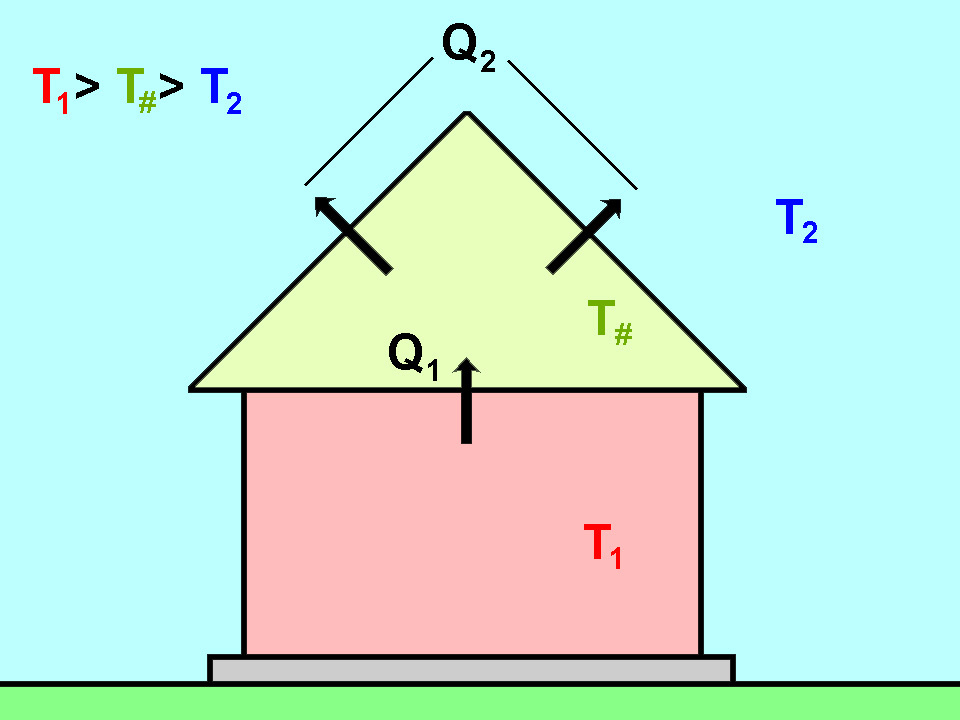
In an insulated but not heated attic room, during the cold period, the temperature is set higher than outside. This is due to the transfer of heat through the floor.
The main problem is that the floor area between the attic and the upper floor is different from the area of the roof and gables. In this case, it is necessary to use the heat transfer balance condition Q1 = Q2.
It can also be written in the following way:
K1 × (T1 - T#) = K2 × (T# - T2),
where:
- K1 = S1 / R1 + … + Sn / Rn to overlap between the warm part of the house and the cold room;
- K2 = S1 / R1 + … + Sn / Rn for overlapping between a cold room and the street.
From the equality of heat transfer, we find the temperature that will be established in a cold room at known values in the house and on the street. T# = (K1 × T1 + K2 × T2) / (K1 + K2). After that, we substitute the value into the formula and find the heat loss.
Example. Let the inner size of the house be 8 x 10 meters. The roof angle is 30 °. The air temperature in the premises is “+25 ° С”, and outside - “–15 ° С“.
The coefficient of thermal resistance of the ceiling is calculated as in the example given in the section for calculating heat loss through enclosing structures: RNS = 3.65. The overlap area is 80 m2, therefore K1 = 80 / 3.65 = 21.92.
Roof area S1 = (10 × 8) / cos(30) = 92.38. We calculate the coefficient of thermal resistance, taking into account the thickness of the wood (lathing and finishing - 50 mm) and mineral wool (10 cm): R1 = 2.98.
Window area for gable S2 = 1.5. For an ordinary double-glazed window, thermal resistance R2 = 0.4. The area of the pediment is calculated by the formula: S3 = 82 × tg(30) / 4 – S2 = 7.74. The coefficient of resistance to heat transfer is the same as that of the roof: R3 = 2.98.

Heat dissipation through windows accounts for a significant portion of all energy losses. Therefore, in regions with cold winters, you should choose "warm" double-glazed windows
Let's calculate the coefficient for the roof (not forgetting that the number of gables is two):
K2 = S1 / R1 + 2 × (S2 / R2 + S3 / R3) = 92.38 / 2.98 + 2 × (1.5 / 0.4 + 7.74 / 2.98) = 43.69.
Let's calculate the air temperature in the attic:
T# = (21.92 × 25 + 43.69 × (–15)) / (21.92 + 43.69) = –1.64 ° С.
Substitute the resulting value into any of the formulas for calculating heat loss (provided that they are equal in balance) and we get the desired result:
Q1 = K1 × (T1 – T#) = 21.92 × (25 - (–1.64)) = 584 W.
Cooling through ventilation
The ventilation system is installed to maintain a normal microclimate in the house. This leads to the inflow of cold air into the room, which must also be taken into account when calculating heat loss.
Requirements for the volume of ventilation are spelled out in several regulatory documents. When designing an intra-house system of a cottage, first of all, you need to take into account the requirements of §7 SNiP 41-01-2003 and §4 SanPiN 2.1.2.2645-10.
Since the generally accepted unit for measuring heat loss is watt, the heat capacity of air c (kJ / kg × ° С) must be reduced to the dimension “W × h / kg × ° С”. For air at sea level, you can take the value c = 0.28 W × h / kg × ° С.
Since the ventilation volume is measured in cubic meters per hour, it is also necessary to know the air density q (kg / m3). At normal atmospheric pressure and average humidity, this value can be taken q = 1.30 kg / m3.

Household ventilation unit with a recuperator. The declared volume, which it passes, is given with a small margin of error. Therefore, it makes no sense to accurately calculate the density and heat capacity of air on the ground to hundredths.
The energy consumption for compensation of heat losses as a result of ventilation can be calculated using the following formula:
Q = L × q × c × dT = 0.364 × L × dT,
where:
- L - air consumption (m3 / h);
- dT - temperature difference between room and incoming air (° С).
If cold air enters the house directly, then:
dT = T1 - T2,
where:
- T1 - indoor temperature;
- T2 - the temperature outside.
But for large objects, the ventilation system is usually integrate the recuperator (heat exchanger). It allows you to significantly save energy resources, since partial heating of the incoming air occurs due to the temperature of the outgoing stream.
The efficiency of such devices is measured in their efficiency k (%). In this case, the previous formula will take the form:
dT = (T1 - T2) × (1 - k / 100).
Gas consumption calculation
Knowing total heat loss, you can quite simply calculate the required consumption of natural or liquefied gas for heating a house with an area of 200 m2.
The amount of energy released, in addition to the volume of fuel, is affected by its heat of combustion. For gas, this indicator depends on the moisture content and the chemical composition of the supplied mixture. Distinguish between the highest (Hh) and lower (Hl) calorific value.
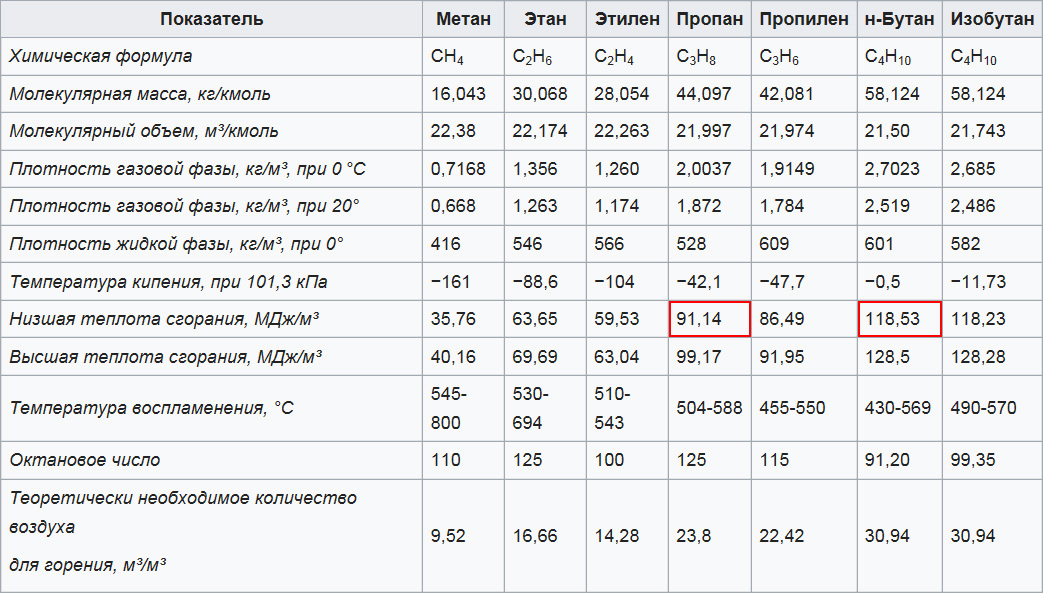
The lower calorific value of propane is less than that of butane. Therefore, in order to accurately determine the calorific value of liquefied gas, you need to know the percentage of these components in the mixture supplied to the boiler.
To calculate the amount of fuel that is guaranteed to be enough for heating, the value of the net calorific value is substituted into the formula, which can be obtained from the gas supplier. The standard unit for calorific value is “mJ / m3”Or“ mJ / kg ”. But since the units of measurement for both the power of the boilers and the heat loss operate with watts, and not joules, it is necessary to perform a conversion, taking into account that 1 mJ = 278 W × h.
If the value of the net calorific value of the mixture is unknown, then it is permissible to take the following averaged figures:
- for natural gas Hl = 9.3 kW × h / m3;
- for liquefied gas Hl = 12.6 kW × h / kg.
Another indicator required for calculations is the boiler efficiency. K. It is usually measured as a percentage. The final formula for gas consumption over a period of time E (h) has the following form:
V = Q × E / (Hl × K / 100).
The period when centralized heating in houses is turned on is determined by the average daily air temperature.
If during the last five days it does not exceed “+ 8 ° C”, then according to the Decree of the Government of the Russian Federation No. 307 of 13.05.2006, the supply of heat to the house must be ensured. For private houses with autonomous heating, these figures are also used when calculating fuel consumption.
The exact data on the number of days with a temperature not higher than “+ 8 ° C” for the area where the cottage is built can be obtained from the local department of the Hydrometeorological Center.
If the house is located close to a large settlement, then it is easier to use the table. 1. SNiP 23-01-99 (column number 11). Multiplying this value by 24 (hours a day) we get the parameter E from the equation for calculating the gas flow rate.
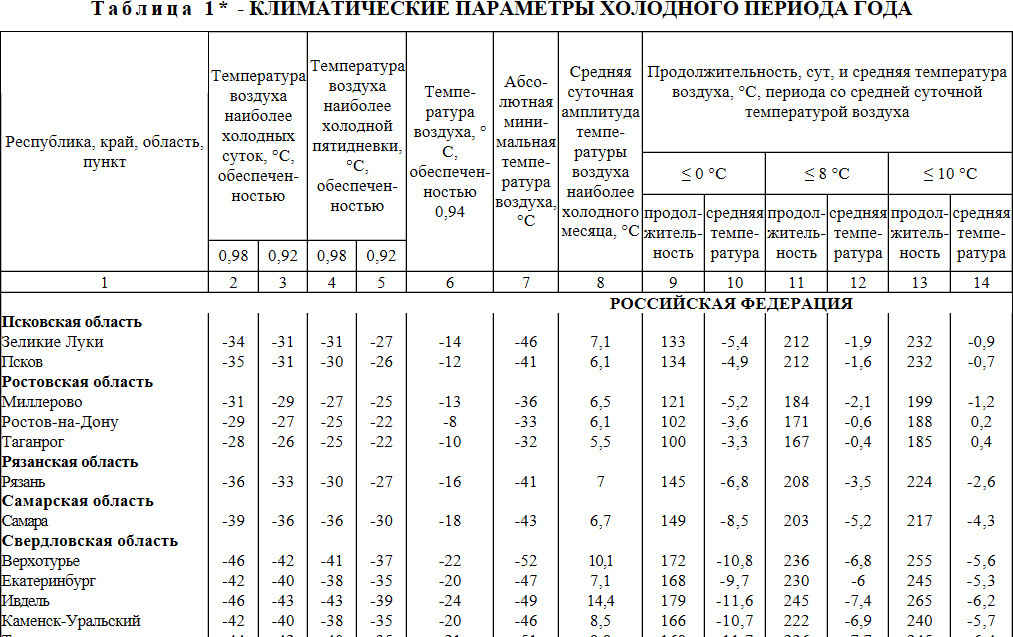
According to climatic data from table. 1 SNiP 23-01-99, construction organizations carry out calculations to determine the heat loss of buildings
If the volume of air flow and the temperature inside the premises are constant (or with slight fluctuations), then heat loss both through the enclosing structures and due to the ventilation of the premises will be directly proportional to the temperature outside air.
Therefore, for the parameter T2 in the equations for calculating heat loss, you can take the value from column No. 12 of the table. 1. SNiP 23-01-99.
Example for a 200 m cottage2
Let's calculate the gas consumption for a cottage near the city. Rostov-on-Don. Heating period duration: E = 171 × 24 = 4104 h. Average outdoor temperature T2 = - 0.6 ° C. Desired temperature in the house: T1 = 24 ° C.
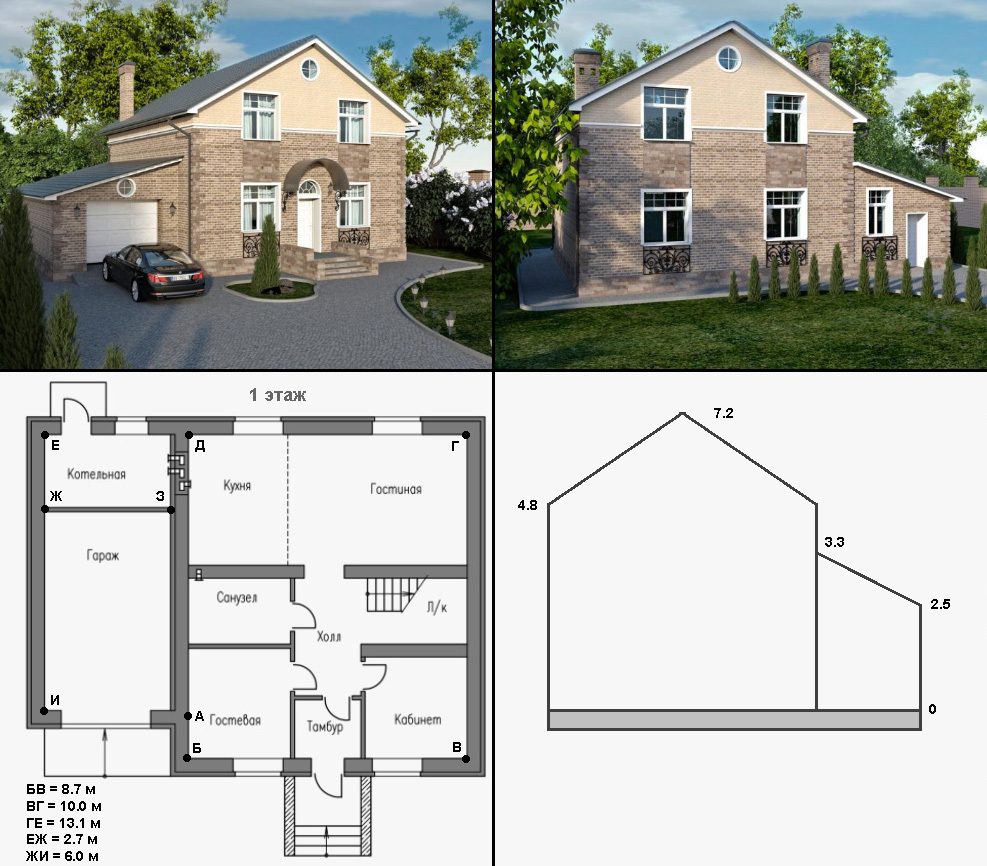
Two-storey cottage with an unheated garage. The total area is about 200 m2. The walls are not additionally insulated, which is permissible for the climate of the Rostov region
Step 1. Let's calculate the heat loss through the perimeter without taking into account the garage.
To do this, select homogeneous areas:
- Window. In total there are 9 windows measuring 1.6 × 1.8 m, one window measuring 1.0 × 1.8 m and 2.5 round windows with an area of 0.38 m2 each one. Total window area: Swindow = 28.60 m2. According to the product passport Rwindow = 0.55. Then Qwindow = 1279 W.
- Doors. There are 2 insulated doors 0.9 x 2.0 m in size.Their area: Sdoors = 3.6 m2. According to the product passport Rdoors = 1.45. Then Qdoors = 61 W.
- Blank wall. Section "ABVGD": 36.1 × 4.8 = 173.28 m2. Plot “YES”: 8.7 × 1.5 = 13.05 m2. Section "DEJ": 18.06 m2. Roof gable area: 8.7 × 5.4 / 2 = 23.49. Total, blank wall area: Swall = 251.37 – Swindow – Sdoors = 219.17 m2. The walls are made of 40 cm thick aerated concrete and hollow facing bricks. Rwalls = 2.50 + 0.63 = 3.13. Then Qwalls = 1723 W.
Total heat loss through the perimeter:
Qperim = Qwindow + Qdoors + Qwalls = 3063 W.
Step 2. Let's calculate the heat loss through the roof.
The insulation is a solid lathing (35 mm), mineral wool (10 cm) and lining (15 mm). Rroofs = 2.98. Roof area above the main building: 2 × 10 × 5.55 = 111 m2, and above the boiler room: 2.7 × 4.47 = 12.07 m2. Total Sroofs = 123.07 m2. Then Qroofs = 1016 W.
Step 3. Let's calculate the heat loss through the floor.
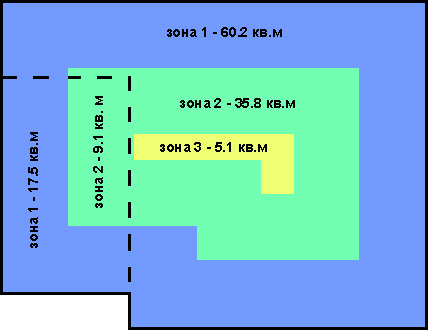
The zones for the heated room and the garage must be calculated separately. The area can be determined exactly by mathematical formulas, or you can use vector editors such as Corel Draw
Resistance to heat transfer is provided by rough floor boards and plywood under the laminate (5 cm in total), as well as basalt insulation (5 cm). Rsex = 1.72. Then the heat loss through the floor will be equal:
Qfloor = (S1 / (Rfloor + 2.1) + S2 / (Rfloor + 4.3) + S3 / (Rfloor + 2.1)) × dT = 546 W.
Step 4. Let's calculate the heat loss through a cold garage. Its floor is not insulated.
Heat penetrates from a heated house in two ways:
- Through the load-bearing wall. S1 = 28.71, R1 = 3.13.
- Through a brick partition from the boiler room. S2 = 11.31, R2 = 0.89.
We get K1 = S1 / R1 + S2 / R2 = 21.88.
Heat comes out of the garage as follows:
- Through the window. S1 = 0.38, R1 = 0.55.
- Through the gate. S2 = 6.25, R2 = 1.05.
- Through the wall. S3 = 19.68, R3 = 3.13.
- Through the roof. S4 = 23.89, R4 = 2.98.
- Through the floor. Zone 1. S5 = 17.50, R5 = 2.1.
- Through the floor. Zone 2. S6 = 9.10, R6 = 4.3.
We get K2 = S1 / R1 + … + S6 / R6 = 31.40
Let's calculate the temperature in the garage, subject to the balance of heat transfer: T# = 9.2 ° C. Then the heat loss will be equal: Qgarage = 324 W.
Step 5. Let's calculate the heat loss due to ventilation.
Let the calculated volume of ventilation for such a cottage with 6 people living in it be 440 m3/час. The system has a recuperator with an efficiency of 50%. Under these conditions, heat loss: Qvent = 1970 W.
Step. 6. Let us determine the total heat loss by adding up all the local values: Q = 6919 W.
Step 7. Let's calculate the volume of gas required to heat a model house in winter with a boiler efficiency of 92%:
- Natural gas. V = 3319 m3.
- Liquefied gas. V = 2450 kg.
After calculations, you can analyze the financial costs of heating and the feasibility of investments aimed at reducing heat loss.
Conclusions and useful video on the topic
Thermal conductivity and resistance to heat transfer of materials. Calculation rules for walls, roof and floor:
The most difficult part of the calculations for determining the volume of gas required for heating is finding the heat loss of the heated object. Here, first of all, you need to carefully consider geometric calculations.
If the financial costs for heating seem excessive, then you should think about additional insulation of the house. Moreover, the calculations of heat loss show the structure of freezing well.
Please leave comments in the block below, ask questions on unclear and interesting points, post photos on the topic of the article. Share your own experience in carrying out calculations to find out the cost of heating. It is possible that your advice will greatly help site visitors.


